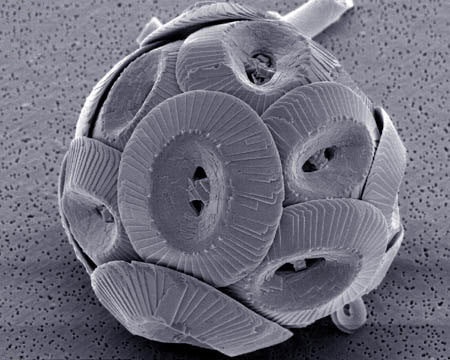 ©2020 Biological and Chemical Oceanography Data Management Office.
©2020 Biological and Chemical Oceanography Data Management Office.Funded by the U.S. National Science Foundation
Collaborative Research: The Great Southern Coccolithophore Belt
Intellectual merit: Recent advances in satellite remote sensing enable estimation of suspended calcium carbonate (particulate inorganic carbon or 'PIC') from space. This radiative approach is operationally specific to marine coccolithophores (Haptophyceae) and sensitive enough to quantify PIC concentrations in oligotrophic gyres. Global images of suspended PIC taken over the seven years of the MODIS Aqua mission show a 'Great Belt' of PIC near the sub-Antarctic front of the Southern Ocean that circles the globe. This feature occurs every year during austral summer and appears to be within the high-nutrient, low chlorophyll region of the Southern Ocean. The area of the Great Belt is ~88 million km2, 26% of the global ocean. Evidence from several cruises into the Great Belt region of the Atlantic, Indian and Pacific sectors has verified elevated concentrations of coccolithophores; previous work in the Atlantic sector verified high optical scattering from PIC. The few ship observations we have are entirely consistent with the satellite views. In this project, the investigators will systematically study the coccolithophores of the Great Belt guided by the following science goals: (a) identify the coccolithophore species within this belt; (b) measure the abundance of coccolithophores and associated PIC; (c) measure coccolithopore calcification rates; (d) elucidate factors that may limit coccolithophore latitudinal range (e.g. stratification, temperature, macronutrients, trace metals, grazing); (e) demonstrate whether the variability in PIC relates to shallow export flux; (f) define how variability in PIC production relates to the pCO2, total alkalinity and dissolved inorganic carbon budgets; and (g) examine the impact of short-term ocean acidification on coccolithophore growth and calcite dissolution.
The research will involve cruises along the 50 S parallel to sample the Great Belt, during the austral summer. The investigators will use a combination of underway surface sampling (primarily optical and hydrographic) and vertical station profiles (using CTD/rosette and large volume submersible pumps) to address hypotheses related to the above goals. The cruise track will elucidate both zonal and meridional variability in the Great Belt. Controlled carboy incubation experiments will examine the impact of ocean acidification at various future scenarios on coccolithophore growth and dissolution. Dilution experiments will address grazing-related mortality and dissolution questions. Controlled metal-addition incubations will focus on potential iron, zinc and cobalt limitation of the coccolithophores or competition from diatoms related to silica availability. The proposed field observations and metal-addition experiments will provide important information on the current status of the Great Belt in the context of global biogeochemistry. The ocean acidification experiments to be undertaken are more forward-looking in terms of the fate of the Southern Ocean coccolithophores in a future acidified ocean.
Broader impacts: The globally significant size of the Great Belt indicates that it likely plays a major role in global biogeochemistry and climate change feedbacks. Thus, the investigators expect this work to have broad, transformative impacts in biological and chemical oceanography. Ocean acidification from the burning of fossil fuels is predicted to lower the pH of the surface ocean by 0.3 units in the next century and up to 0.7 units - a 5-fold increase in the proton concentration by the year 2300. A major goal of this study is to examine the effects of ocean acidification on coccolithophores in a region of low calcite saturation (i.e., one of the first regions expected to become sub-saturating for calcite). The results of these experiments will therefore be highly relevant to our basic understanding of the marine carbon cycle. Related to career development and Criterion II activities, the project includes field experience on two cruises for NSF REU undergraduates from Maine universities or colleges, providing funds for them to attend a scientific meeting. Participation of undergraduate students from Maine colleges builds capacity in our rural coastal state and helps thwart the serious issue of 'brain drain', in which the best students are leaving Maine to seek opportunity in wealthier, more populated states. A teacher will also participate on the cruises (via the NSF-sponsored ARMADA program). This teacher will develop learning modules for students about such topics as coccolithophores, calcification, export production, metal-plankton interactions, ocean acidification and climate change.
PUBLICATIONS PRODUCED AS A RESULT OF THIS RESEARCH
Balch, WM; Drapeau, DT; Bowler, BC; Lyczskowski, E; Booth, ES; Alley, D. "The contribution of coccolithophores to the optical and inorganic carbon budgets during the Southern Ocean Gas Exchange Experiment: New evidence in support of the "Great Calcite Belt" hypothesis," JOURNAL OF GEOPHYSICAL RESEARCH-OCEANS, v.116, 2011. View record at Web of Science
Poulton, AJ; Young, JR; Bates, NR; Balch, WM. "Biometry of detached Emiliania huxleyi coccoliths along the Patagonian Shelf," MARINE ECOLOGY-PROGRESS SERIES, v.443, 2011, p. 1. View record at Web of Science
BOOKS/ONE TIME PROCEEDING
Brown, Michael S, W. Balch, S. Craig, B. Bowler, D. Drapeau, J. Grant. "Optical closure within a Patagonian Shelf coccolithhophore bloom", 06/01/2011-05/31/2012, 2012, "ACCESS'12. Atlantic Canada Coastal & Estuarine Science Society. Dalhousie University, Halifax, Nova Scotia. 10-13 May, 2012.".

Principal Investigator: William M. Balch
Bigelow Laboratory for Ocean Sciences
Co-Principal Investigator: Nicholas Bates
Bermuda Institute of Ocean Sciences (BIOS)
Co-Principal Investigator: Phoebe J. Lam
Woods Hole Oceanographic Institution (WHOI)
Co-Principal Investigator: Benjamin Twining
Bigelow Laboratory for Ocean Sciences
Project Coordinator: Mr Bruce Bowler
Bigelow Laboratory for Ocean Sciences
Contact: William M. Balch
Bigelow Laboratory for Ocean Sciences
BCO-DMO Data Manager: Stephen R. Gegg
Woods Hole Oceanographic Institution (WHOI BCO-DMO)